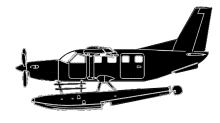
ASN Wikibase Occurrence # 169455
This information is added by users of ASN. Neither ASN nor the Flight Safety Foundation are responsible for the completeness or correctness of this information.
If you feel this information is incomplete or incorrect, you can submit corrected information.
| Date: | Sunday 30 September 2012 |
| Time: | 15:45 |
| Type: |  Quest Kodiak 100 |
| Owner/operator: | U.S. Fish & Wildlife Service |
| Registration: | N745 |
| MSN: | 100-0022 |
| Year of manufacture: | 2009 |
| Total airframe hrs: | 284 hours |
| Engine model: | P&W Canada PT6A-34 |
| Fatalities: | Fatalities: 0 / Occupants: 1 |
| Aircraft damage: | Substantial |
| Category: | Accident |
| Location: | Lake Hood Seaplane Base, Anchorage, Alaska -
 United States of America United States of America
|
| Phase: | Landing |
| Nature: | Unknown |
| Departure airport: | Kenai Airport, AK (ENA/PAEN) |
| Anchorage-Lake Hood, AK (LHD/PALH) | |
| Investigating agency: | NTSB |
| Confidence Rating: |
The pilot was landing an amphibious, float-equipped airplane on a lake on the final leg of a 4-day, wildlife survey operation. The pilot stated that she had not conducted a water landing recently, so she elected to land on the water to maintain proficiency. She said that because the airplane had a tendency to turn left during water landings, she was not comfortable landing it in the lake’s water lane (a confined area). Before landing, the pilot set about 50% right rudder trim to compensate for the left-turning tendency and confirmed that the wheels were in the up position. She noted that her airspeed during the approach was slightly faster than normal. The pilot said that during touchdown, the airplane veered to the left, then to the right, then veered violently to the right, as though it "caught a float," and the right wing struck the water. The airplane then pivoted abruptly to the right, cartwheeled, and began to sink. The pilot was able to escape through a broken side window.
Postaccident examination of the airframe and engine revealed no evidence of mechanical malfunctions or failures that would have precluded normal operation.
The flight in the government-owned, government-operated airplane was a public aircraft operation (PAO). Because the Federal Aviation Administration (FAA) has no statutory authority to regulate PAOs, the agency’s training program was not subject to civil aircraft requirements. A review of the flight training program revealed that it did not include curriculums, events, or testing and checking procedures. No written maneuvers and procedures guide with acceptable performance standards had been developed. As a result, no standardization existed within the pilot group, and tribal knowledge and experimentation were accepted as part of the organization’s culture. Multiple checklists existed for the airplane, and pilots were allowed to use whichever checklist they preferred. The agency did not, nor was it required to, incorporate best practices and industry standards into its training program and airplane operations, and no FAA oversight was required or provided. The agency’s vendor pilot requirements were substantially higher with stricter standards, and required FAA oversight, compared to those for agency pilots flying similar missions.
The pilot had logged 232 flight hours in the accident make and model airplane, including 68 water landings, only 2 of which were logged without an instructor on board. She stated that during her training in the accident make and model airplane, she completed only one step turn. She further stated that during her interagency pilot evaluation/qualification check, step turns were not completed. The pilot said that the check pilot was not comfortable performing the maneuver, so they agreed to sign off the maneuver on the check ride form but did not accomplish the task. Because performing step turns develops a pilot’s skill in maintaining directional control of a floatplane during high-speed water taxiing, if the pilot had received thorough training in performing step turns in the accident make and model airplane, she would have been less likely to lose control of the airplane during landing.
Probable Cause: The pilot's failure to maintain directional control while landing, which resulted in a collision with the water. Contributing to the accident were the pilot's lack of experience conducting waterborne operations in the accident make and model airplane and the public aircraft operator’s lack of training standardization.
Accident investigation:
 |
|
Sources:
NTSB
Location
Revision history:
| Date/time | Contributor | Updates |
|---|---|---|
| 02-Sep-2014 11:49 | Aerossurance | Added |
| 02-Sep-2014 11:50 | Aerossurance | Updated [Source] |
| 14-Jun-2015 18:56 | wf | Updated [Cn] |
| 21-Dec-2016 19:28 | ASN Update Bot | Updated [Time, Damage, Category, Investigating agency] |
| 11-Nov-2017 11:47 | wf | Updated [Aircraft type] |
| 28-Nov-2017 13:25 | ASN Update Bot | Updated [Operator, Other fatalities, Nature, Departure airport, Destination airport, Source, Narrative] |
| 01-May-2022 08:18 | Ron Averes | Updated [Operator] |
| 12-Nov-2022 02:05 | Ron Averes | Updated [Operator, Departure airport, Destination airport] |
Corrections or additions? ... Edit this accident description
The Aviation Safety Network is an exclusive service provided by:


 ©2024 Flight Safety Foundation
©2024 Flight Safety Foundation